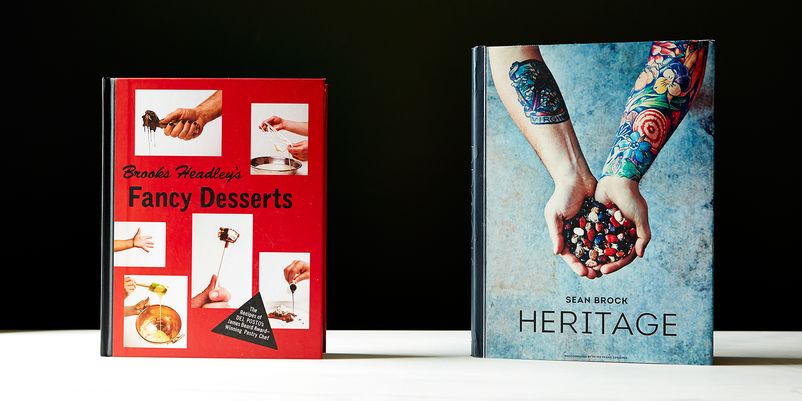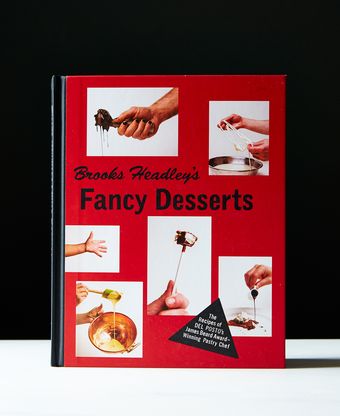I will admit to initial misgivings concerning Brooks Headley’s Fancy Desserts. A former punk rocker, the pastry chef at Del Posto has rigged his cookbook with artifacts from his days spent creating a towering wall of sound -- here is a photo of a pair of broken, splintery drumsticks; here is a poster from when Spitboy, Universal Order of Armageddon, and Man Is the Bastard all played Berkeley. I mean, dood.
Sean Brock’s Heritage, by contrast, seemed at first blush to be homespun, simple, heartening -- look, please, at the photos of chickens and a tractor and a hog; note the awesome-looking and terrific-sounding Breast of Guinea Hen Pan-Roasted on the Bone with Oats, Ramps, and Parsnips.
But as soon as I started cooking from the two books, my first impressions started to shift.
My first step was to tally the number of recipes in each book that a) I wanted to make and b) didn’t require wildly out-of-season produce, special ordering, or trips beyond my local Whole Foods or Chinatown markets. The Headley book had 25, but the Brock -- because he is so devoted to heirloom veggies and benne and fennel pollen and seasonal fruit -- had only 14.
I started with Brock, making his Southern take on the classic Provençal barigoule, in which he’s substituted its traditional ingredient, artichokes, with eggplant. Finished with a 1/2 cup of white wine and a 1/4 cup of Cynar or dry vermouth (I used the latter, as artichoke liqueur is a longstanding source of humor in my household), this was, when served over rice, a hearty and terrific way to combat a cold winter night. Seared cubes of eggplant + winey sauce = happy face decal. Two nights later I made Brock’s Chicken Simply Roasted in a Skillet (a beautifully-seared and then roasted chicken half is topped with garlic “confit” and a pan sauce that’s been graced with slivers of Italian parsley and the juice and zest of a lemon). My boyfriend and I devoured it, instantly forming a relationship with the sauce that bordered on the vampiric; I am quite sure that this is a recipe I will be making for the rest of my life. The lemon and parsley separate it from the roasted chicken ranks.
When it comes to dinner, the two “money” words in my household are mustard and carrots. So, on seeing that Headley had a recipe for candied carrots, I knew I had to try them. They took seconds to make (sear carrots in olive oil; sprinkle with sugar; finish with butter), and proved to be a lively and unexpected accompaniment to chicken curry. A good start.
Next I made Headley’s Red Wine Plums, wherein dried plums are stewed in red wine, some sugar, and the zest of orange: Yes, please. Headley suggests serving it with a chestnut cake, but I decided to go off-road and use vanilla Haagen Dazs -- I can defy authority, too, dood, and frozen dessert products are my CBGB.
But my favorite Headley offering was Brutti Ma Buoni, the hazelnut meringue whose name translates as Ugly But Good. Because I love to touch and manipulate food (no-knead bread: Who would bother?), the fact that I would get to make flattish meringue cookies and then, while they’re still hot, scrunch them into weird, crusty Monet haystacks was very exciting to me. In my next life, when my work as a massager of kale and octopus and Kobe beef starts to contort my upper body from over-use, I will hang up my shingle as a meringue aggregator. As Taylor Swift is to youngfolk, I will be to elderly Italian women.
Or will this same demographic think I’m the devil? Shortly after making Brutti Ma Buoni a second time, I realized: roasted peanuts. Their saltiness and crunch, when injected into the template of the weird, crusty Monet haystack, produces a flavor profile that is admittedly more terrestrial than its hazelnut progenitor, but somehow more nutty, more savory, more convincing. A hazelnut meringue is something you give to a small child or a dowager, certain that its bracing amount of sugar will render them tongue-lolling and couch-bound in a crowded hotel lobby in Zurich. But a peanut meringue has more possibilities. You could serve them to a sunburned family who has spent too many hours on a boat. You could warm the soul of someone going through a difficult break-up.
What’s confounding about Brutti Ma Buoni is that, despite seeming so rich and luxuriant, they consist solely of nuts, egg whites, sugar, cinnamon, vanilla, and salt. No butter.
Which brings me to a larger point: Though I had great results with both books, Headley arrived at his results with far fewer ingredients. Two of the Headley items I made had 5 ingredients and one had 6; the Brock dishes, by contrast, had 22 and 24 (if, as Brock suggests, you make your own chicken stock). Granted, Brock’s dishes were entrées and Headley’s desserts; but we are talking about a factor of four here.
I so admire chefs who can make something unexpected from a few ordinary ingredients. And while, yes, I also admire a chef like Brock who champions heritage ingredients and who is re-positioning an entire cuisine, this second kind of admiration is a more passive one for me.
At the risk of sounding more shallow than you already think me, I will point out that the two books’ appearance seems to mirror my ultimate feelings about the books as a whole. When I look at Brock’s oversized, jacketed tome lying on my stack of cookbooks, I think, “That is a lovely monument to a chef and his mandate.” When I look at Headley’s unjacketed, textbook-like work, I think, “Next batch: walnuts.”



30 Comments